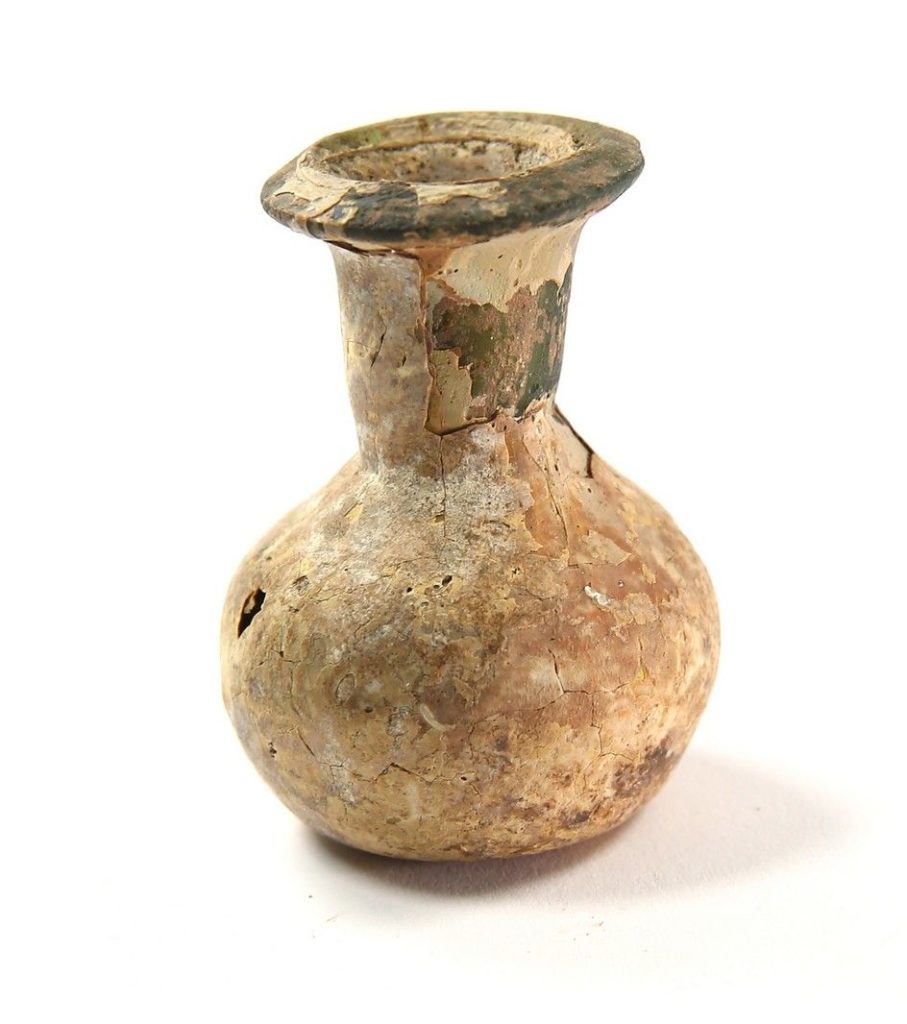
The Islamic period (the period of Islamic rule in the region between the years 638-1917, ecept for a brief period of Crusader rule). 3.5×4.6 cm. Fine condition.
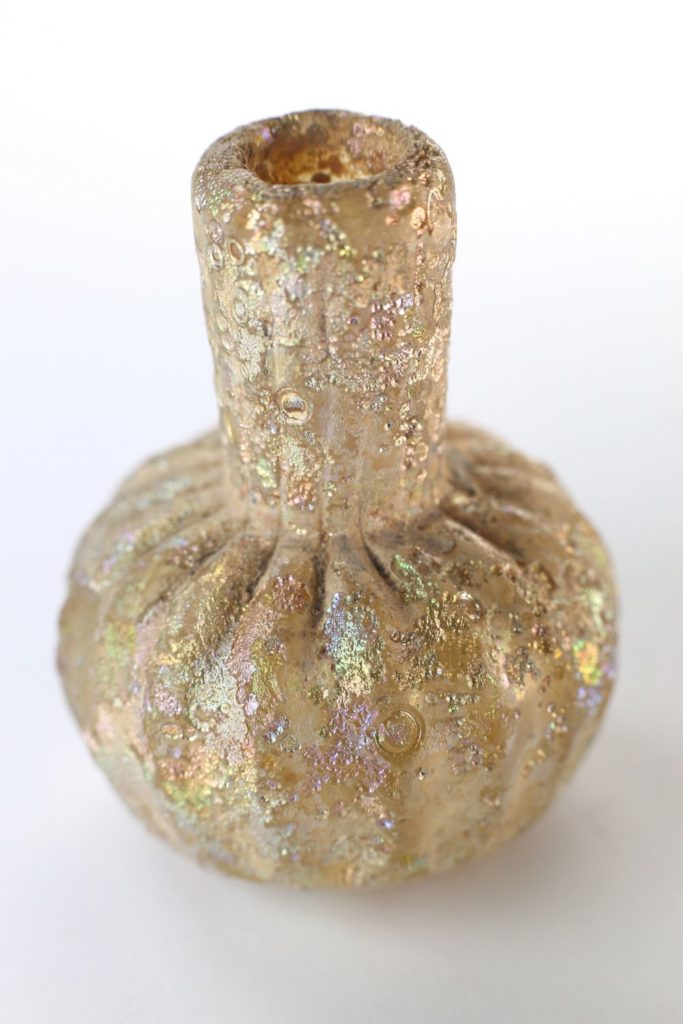
The Islamic period (Islamic rule in the region between the years 638-1917 CE, with a slight interval of Crusader rule); 4.4×3.4 cm. Very fine condition.
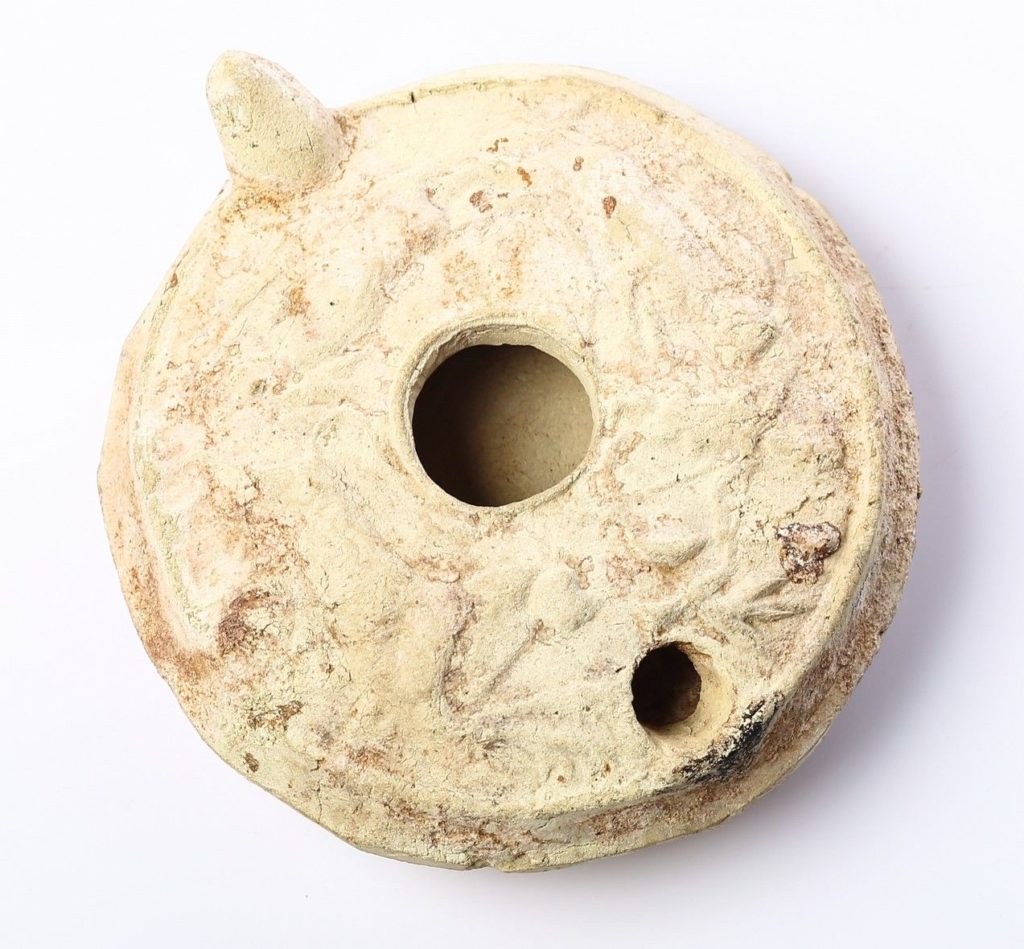
The seventh-eighth century CE. Diameter 11 cm, Height 44 cm. Fine condition.

Obv.: A canopy surrounded by Greek inscription AΓPIΠA BACIɅEWC (of king Agrippa). Rev.: Three ears of grain and the date Lς (sixth year). 41/2 C.E. 2.20 grams, 17 mm, axis 12. Cf. Ya’akov Meshorer, A Treasury of Jewish Coins (New York 2001), pl. 52, no. 120
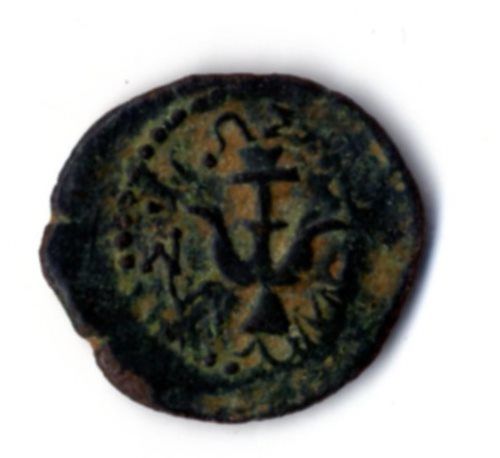
obv: Anchor surrounded by Greek inscription AΛ[EΞ]ANΔPOY BAΣIΛEΩΣ (of King Alexander). Rev.: Eight pointed star within diadem; between the rays, paleo-Hebrew inscription Yehonatan the King. 103-76 B.C.E. Cf. Ya’akov Meshorer, A Treasury of Jewish Coins (New York 2001), pl. 25 sub-group K After the ‘Maccabaean Revolt’, the Hasmonaean kingdom was founded which lasted for just under a hundred years. The alphabet employed was not the square Hebrew script current at the time, but the script from the First Temple period, implying a connection between the Hasmoneans and the First Temple. The symbols employed show a clear Hellenising trend.
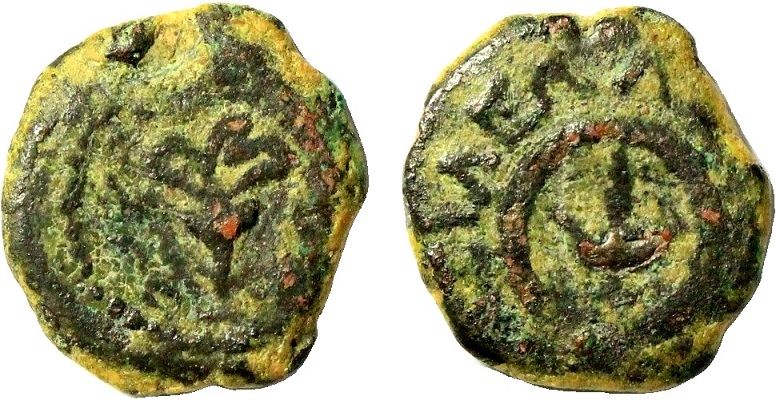
obv: Anchor surrounded by Greek inscription [AΛEΞANΔPOY] [BA]ΣIΛEΩΣ (of King Alexander). Rev.: Lily flower surrounded by paleo-Hebrew inscription: (Yehonatan the King). 103-76 B.C.E. 1.93 grams, 15 mm, axis 6. For similar examples see: Ya’akov Meshorer, A Treasury of Jewish Coins (New York 2001), pl. 27 sub-group N. After the ‘Maccabaean Revolt’, the Hasmonaean kingdom was founded which lasted for just under a hundred years. The alphabet employed was not the square Hebrew script current at the time, but the script from the First Temple period, implying a connection between the Hasmoneans and the First Temple. The symbols employed show a clear Hellenising trend.
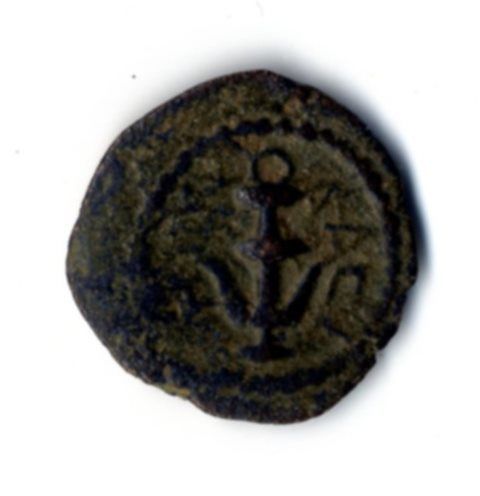
Obv.: Anchor surrounded by Greek inscription H[P]W BACI (abbreviation of HPWΔOY BACIΛEWC; of king Herod). Rev.: Double cornucopia with caduceus between horns and above pellets. 37-4 B.C.E. 2.08 grams, 15 mm, axis 6. Cf. Ya’akov Meshorer, A Treasury of Jewish Coins (New York 2001), pl. 45, no. 59c The Herodian dynasty founded by Herod the Great the ultimate political animal had a number of rulers, the most Jewish of them being Agrippa I. The coins struck by Herod himself were in accordance with Jewish religious sensitivities. Likewise his son Archelaus and his grandson Agrippa struck coins with symbols compatible with Judaism. By way of contrast Agrippa like his brother Antipas and son Agrippa II struck coins with portraits and pagan motifs for his gentile subjects.
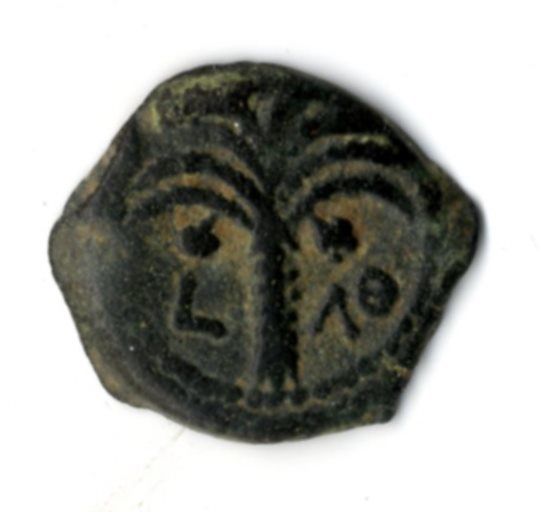
Obv.: Ear of grain surrounded by Greek inscription KAICAPOC (of Caesar). Rev.: Palm tree and underneath the date L ΛΘ (year 39). 9/10 C.E. 2.53 grams, 18 mm, axis 12. Ya’akov Meshorer, A Treasury of Jewish Coins (New York 2001), pl. 73, no. 313 Herod’s son who ruled in Jerusalem, Archelaus, was incompetent so the Romans appointed governors, termed procurators. Most of them, with the exception of Pontius Pilate, respected Jewish religious sensitivities and struck coins with neutral motifs, drawn largely from the seven agricultural species of Israel.
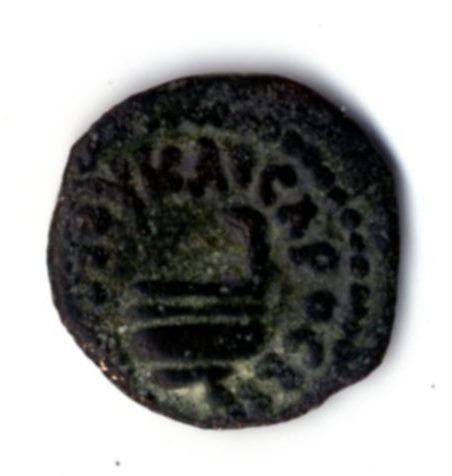
Obv.: Simpulum surrounded by Greek inscription [TIBE]PIOY KAICAPOC L Iς (of Tiberius Caesar, year 16). Rev.: Three ears of grain tied together, surrounded by inscription IOYΛIA KAICAPOC (of Julia Caesaris). 29 C.E. 2.09 grams, 16 mm, axis 11. Cf. Ya’akov Meshorer, A Treasury of Jewish Coins (New York 2001), pl. 74, no. 331 Herod’s son who ruled in Jerusalem, Archelaus, was incompetent so the Romans appointed governors, termed procurators. Most of them, with the exception of Pontius Pilate, respected Jewish religious sensitivities and struck coins with neutral motifs, drawn largely from the seven agricultural species of Israel.
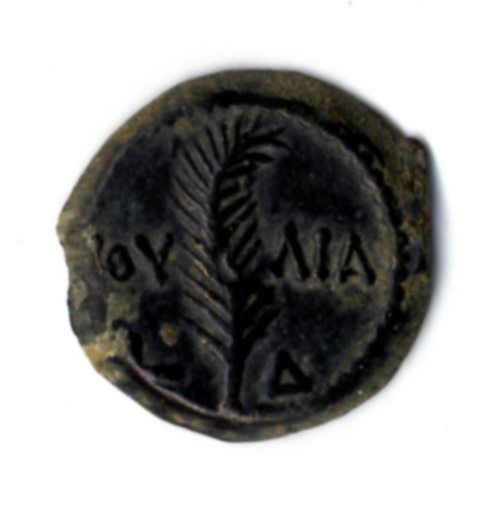
Obv.: Greek inscription TIB KAI CAP (Tiberius Caesar) in a wreath tied at base with an X. Rev.: Upright palm branch and the inscription IOY ΛIA L Δ (Julia, year 4). 17 C.E. 2.29 grams, 17 mm, axis 12. Cf. Ya’akov Meshorer, A Treasury of Jewish Coins (New York 2001), pl. 74, no. 327 Herod’s son who ruled in Jerusalem, Archelaus, was incompetent so the Romans appointed governors, termed procurators. Most of them, with the exception of Pontius Pilate, respected Jewish religious sensitivities and struck coins with neutral motifs, drawn largely from the seven agricultural species of Israel.
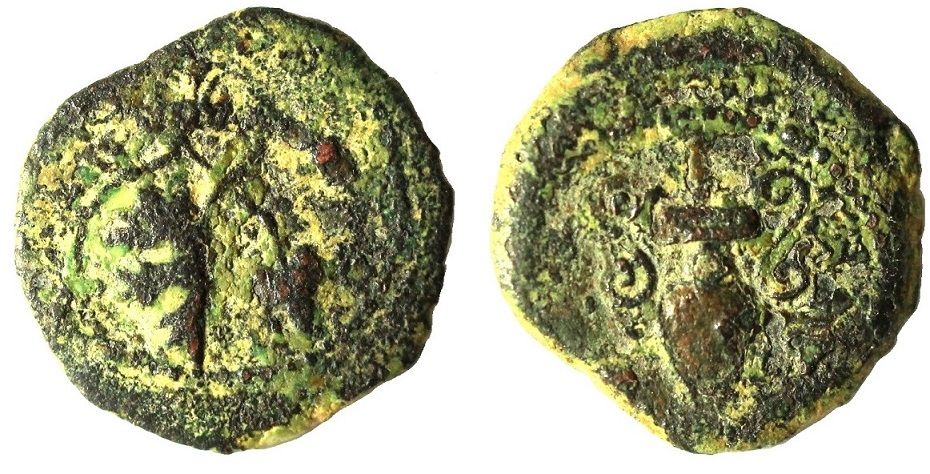
Obv.: Vine branch with leaf, tendril and small bunch of grapes; above it, Greek inscription [IOYΛI]A (Julia). Rev.: Amphora with two handles; across field, the date L Δ (year four). 17 C.E, 2.27 grams, 17 mm, axis 6. Cf. Ya’akov Meshorer, A Treasury of Jewish Coins (New York 2001), pl. 74, no. 326 Herod’s son who ruled in Jerusalem, Archelaus, was incompetent so the Romans appointed governors, termed procurators. Most of them, with the exception of Pontius Pilate, respected Jewish religious sensitivities and struck coins with neutral motifs, drawn largely from the seven agricultural species of Israel.
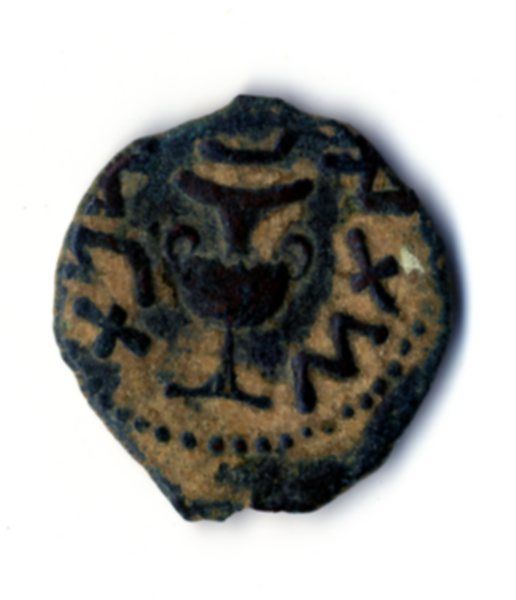
Obv.: Amphora (wine vessel) with wide rim, fluted belly and two handles, and Paleo-Hebrew inscription (year two). Rev.: Vine leaf with small branch and tendril, surrounded by the inscription (freedom of Zion). 67/8 C.E. 2.92 grams, 18 mm, axis 12. Cf. Ya’akov Meshorer, A Treasury of Jewish Coins (New York 2001), pl. 62, no. 197 The Great Revolt, 66-70 CE and also called the Jewish War against the Romans, is remembered in Jewish history for its disastrous consequences, among them widespread physical destruction, killing of hundreds of thousands of Jews culminating in the obliteration of the Second Temple. In the course of the war the Jewish rebels struck coins in silver and bronze as an act of defiance against Rome, since the right to strike coins signified a measure of autonomy. The inscriptions on the coins served as slogans in favour of the uprising, for the Jewish population among whom they circulated, inscriptions such as ‘for the freedom or redemption of Zion’ The shekels and half shekels were coins that could be given as the annual half shekel tax to the Temple. The symbols are largely agricultural produce of the land and vessels used in the Temple service.
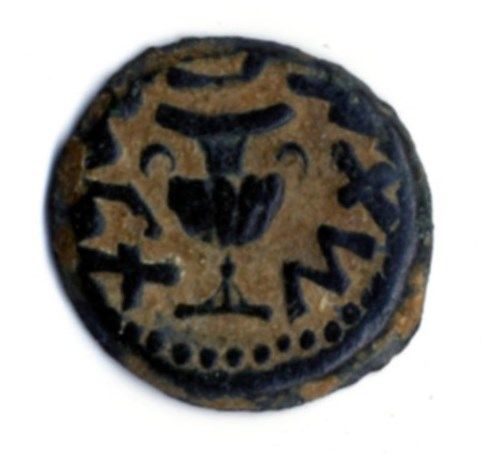
Obv.: Amphora (wine vessel) with wide rim, fluted belly and two handles, and Paleo-Hebrew inscription (year two). Rev.: Vine leaf with small branch and tendril, surrounded by the inscription (freedom of Zion). 67/8 C.E. 2.26 grams, 17 mm, axis 12. Cf. Ya’akov Meshorer, A Treasury of Jewish Coins (New York 2001), pl. 62, no. 197 The Great Revolt, 66-70 CE and also called the Jewish War against the Romans, is remembered in Jewish history for its disastrous consequences, among them widespread physical destruction, killing of hundreds of thousands of Jews culminating in the obliteration of the Second Temple. In the course of the war the Jewish rebels struck coins in silver and bronze as an act of defiance against Rome, since the right to strike coins signified a measure of autonomy. The inscriptions on the coins served as slogans in favour of the uprising, for the Jewish population among whom they circulated, inscriptions such as ‘for the freedom or redemption of Zion’ The shekels and half shekels were coins that could be given as the annual half shekel tax to the Temple. The symbols are largely agricultural produce of the land and vessels used in the Temple service.
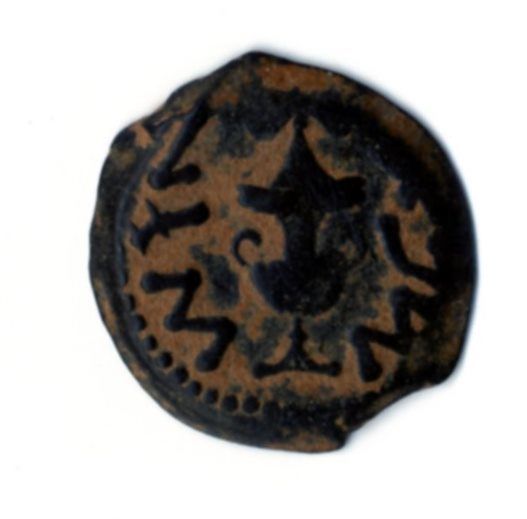
Obv.: Amphora (wine vessel) with lid, wide rim, fluted belly and two handles, and Paleo-Hebrew inscription (year three). Rev.: Vine leaf with small branch and tendril, surrounded by the inscription (freedom of Zion). 68/9 C.E. 2.67 grams, 17 mm, axis 12. Cf. Ya’akov Meshorer, A Treasury of Jewish Coins (New York 2001), pl. 62, no. 204
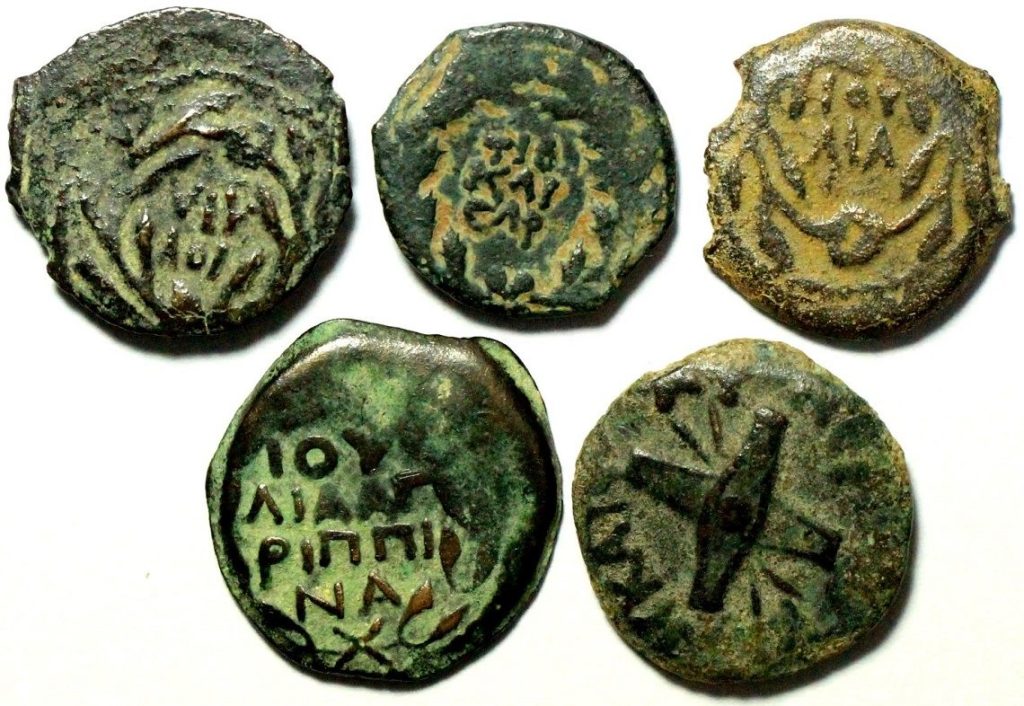
Above, three bronze prutot of Valerius Gratus, depicting upright palm branch (lulav), double cornucopia, three lilies and Greek inscriptions, such as IOY/ ΛIA (Julia) and TIB KAI CAP (Tiberius Caesar). Below, two bronze prutot of Antonius Felix, depicting two oblong shields and two spears, two crossed palm branches palm tree and Greek inscriptions, such as IOY/ ΛIA AΓ/ PIΠΠI/ NA (Julia Agrippina) and NEPW KΛAY KAICAP (Nero Claudius Caesar). Herod’s son who ruled in Jerusalem, Archelaus, was incompetent so the Romans appointed governors, termed procurators. Most of them, with the exception of Pontius Pilate, respected Jewish religious sensitivities and struck coins with neutral motifs, drawn largely from the seven agricultural species of Israel.
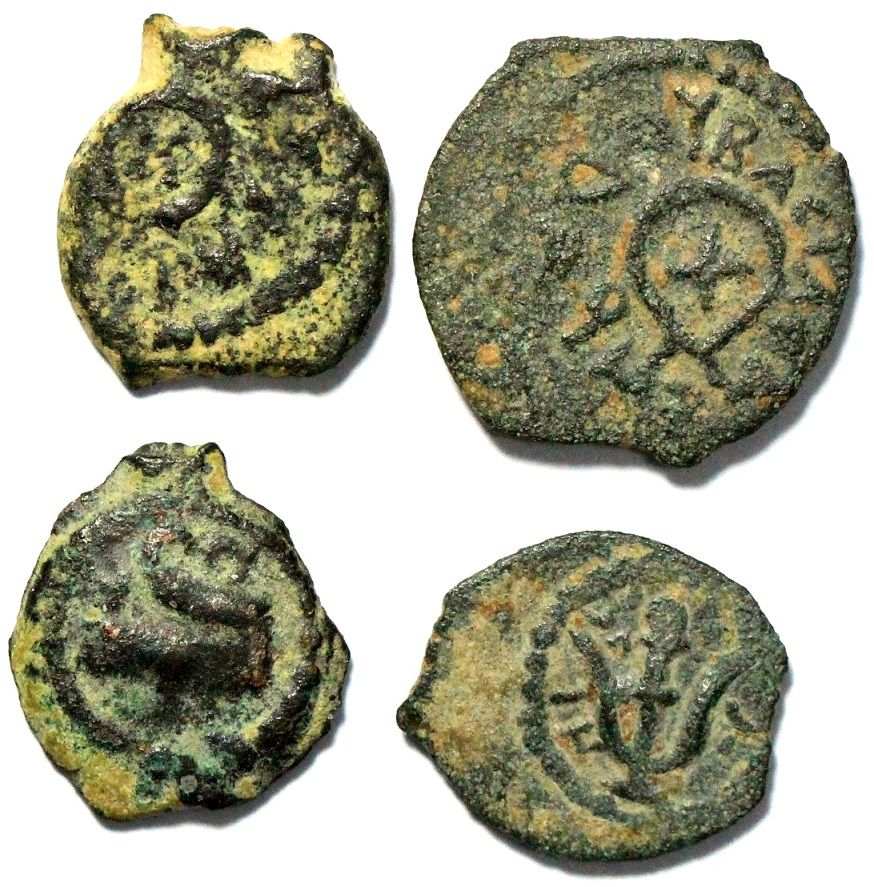
Above, two bronze coins of Herod the Great, depicting a table with three curved legs, palm branches and the Greek inscription HPΩΔOY BAΣIΛEΩΣ (of king Herod). Below, two bronze prutot of Herod Archelaus, depicting a prow of galley, an anchor and an abbreviation of the words EΘNAPXHC (Ethnarch) and HPWΔOY (Herod). The Herodian dynasty founded by Herod the Great the ultimate political animal had a number of rulers, the most Jewish of them being Agrippa I. The coins struck by Herod himself were in accordance with Jewish religious sensitivities. Likewise his son Archelaus and his grandson Agrippa struck coins with symbols compatible with Judaism. By way of contrast Agrippa like his brother Antipas and son Agrippa II struck coins with portraits and pagan motifs for his gentile subjects.
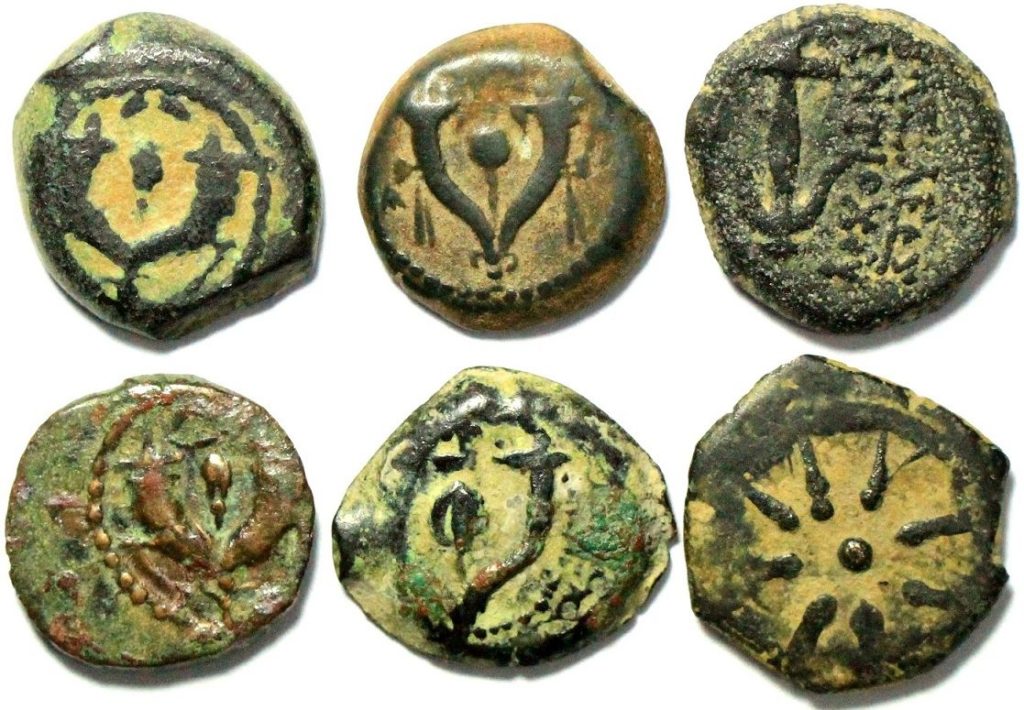
The upper right coin struck by Antiochus VII (Sidetes) in Jerusalem and depicting anchor, Greek inscription ΒΑΣΙΛEΩΣ ANTIOXOY EYEPΓETOY (of king Antiochus the benefactor) a lily flower. The two other coins in the top row struck by John Hyrcanus and depicting Paleo-Hebrew inscription in wreath: Yehohanan the High Priest and council of the Jews and double cornucopia with a pomegranate between horns (there are some differences in the form of the letters in the both coins). In the bottom line, from right to left: A prutah of Alexander Jannaeus, depicting anchor and surrounded by Greek inscription AΛEΞANΔPOY BAΣIΛEΩΣ (of King Alexander) and eight pointed star within diadem; between the rays, paleo-Hebrew inscription (Yehonatan the King). Next to him, a prutah of Alexander Jannaeus including irregular inscription Yehonatan the High Priest and council of the Jews and double cornucopia with a pomegranate between horns. In the left side, a prutah of Judah Aristobulus including Paleo-Hebrew inscription in wreath: Yehudah High Priest and council of Jews and double cornucopia with a pomegranate between horns. After the ‘Maccabaean Revolt’, the Hasmonaean kingdom was founded which lasted for just under a hundred years. The alphabet employed was not the square Hebrew script current at the time, but the script from the First Temple period, implying a connection between the Hasmoneans and the First Temple. The symbols employed show a clear Hellenising trend.
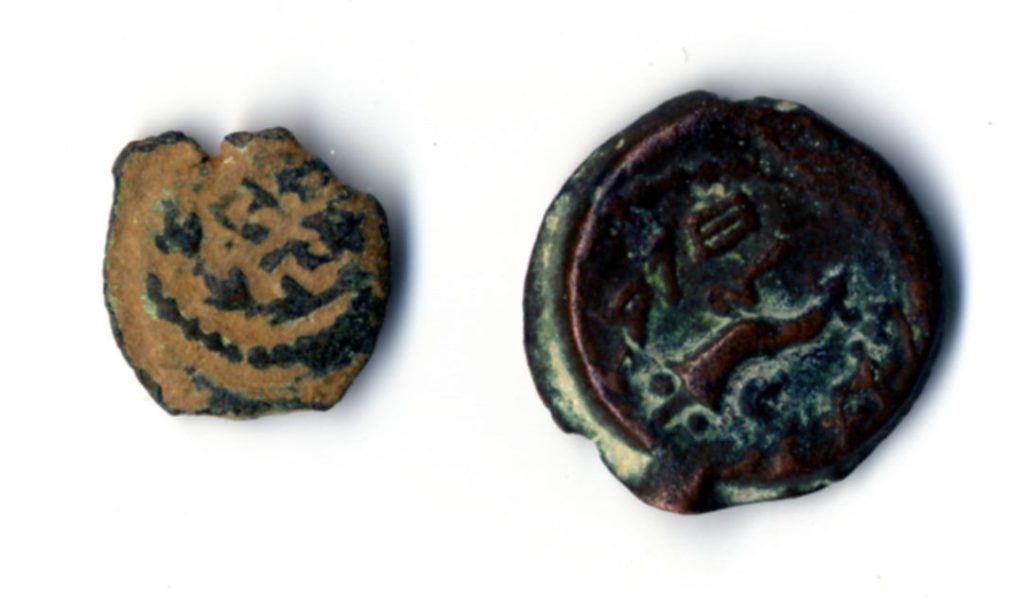
The coins are including cornucopias, paleo-Hebrew inscriptions (‘Mattathias the High Priest’) and Greek inscriptions (‘of King Antigonus’). After the ‘Maccabaean Revolt’, the Hasmonaean kingdom was founded which lasted for just under a hundred years. The alphabet employed was not the square Hebrew script current at the time, but the script from the First Temple period, implying a connection between the Hasmoneans and the First Temple. The symbols employed show a clear Hellenising trend.
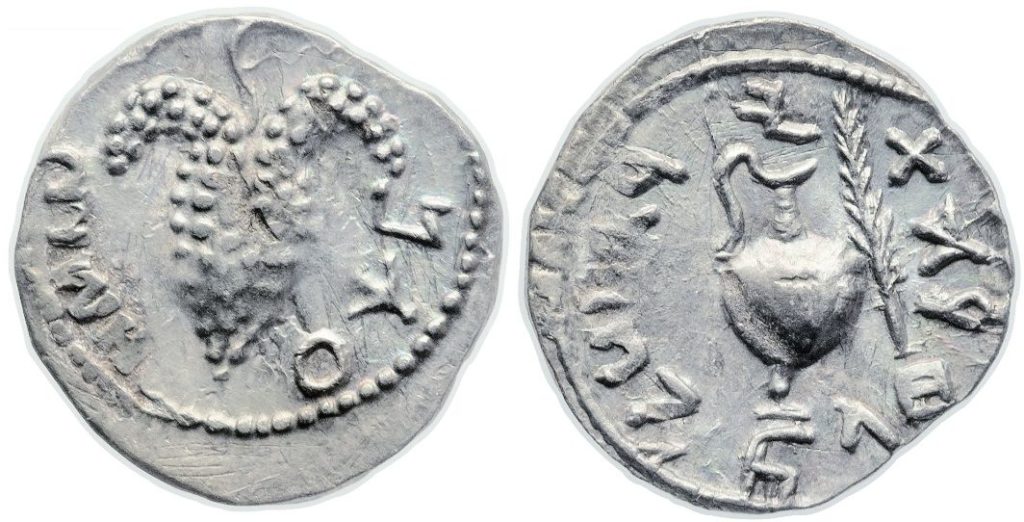
Obv.: A bunch of grapes surrounded by paleo-Hebrew inscription (Shimon). In the margins, vestiges of Latin inscription. Rev: Flagon with handle and palm branch (‘lulav’) on right, surrounded by the inscription (for the freedom of Jerusalem). 132/5 C.E. 2.93 grams, 18 mm, axis 7. Cf. Ya’akov Meshorer, A Treasury of Jewish Coins (New York 2001), pl. 70, no. 285 The Bar Kokhba Revolt (132-135 CE) used similar symbols and inscriptions to the First Revolt. It broke out some seventy years after the destruction of the Second Temple and fifteen years after a Jewish revolt in the diaspora. The tragic consequences of the Revolt led to a pun on the name Bar Kokhba, Bar Cosiba, “son of the lie”. Bar-Kokhba coins were struck on Roman coins.
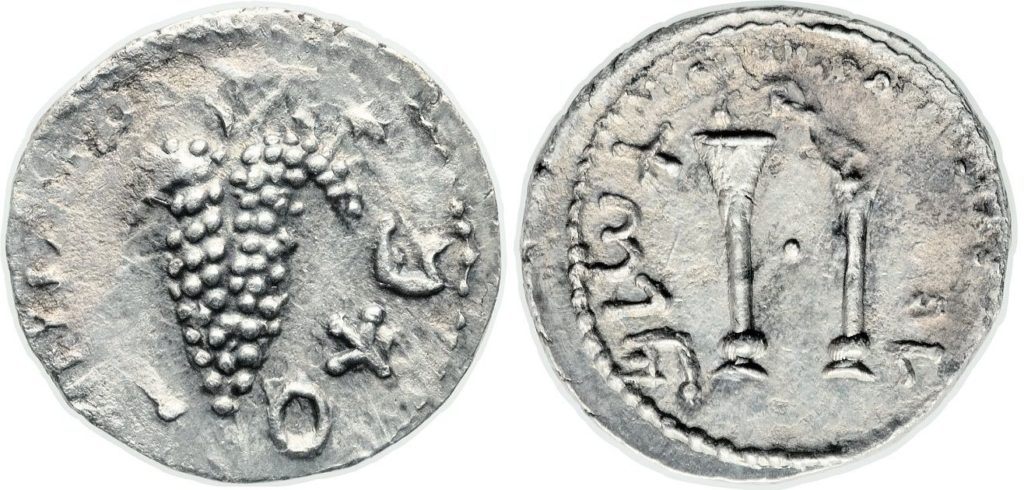
Obv.: A bunch of grapes surrounded by paleo-Hebrew inscription (Shimon). In the margins, vestiges of Latin inscription. Rev: Two trumpets surrounded by inscription (for the freedom of Jerusalem). In the margins, vestiges of Latin inscription. 132/5 C.E. 3.09 grams, 19 mm, axis 7. Cf. Ya’akov Meshorer, A Treasury of Jewish Coins (New York 2001), pl. 70, no. 277. The Bar Kokhba Revolt (132-135 CE) used similar symbols and inscriptions to the First Revolt. It broke out some seventy years after the destruction of the Second Temple and fifteen years after a Jewish revolt in the diaspora. The tragic consequences of the Revolt led to a pun on the name Bar Kokhba, Bar Cosiba, “son of the lie”. Bar-Kokhba coins were struck on Roman coins.
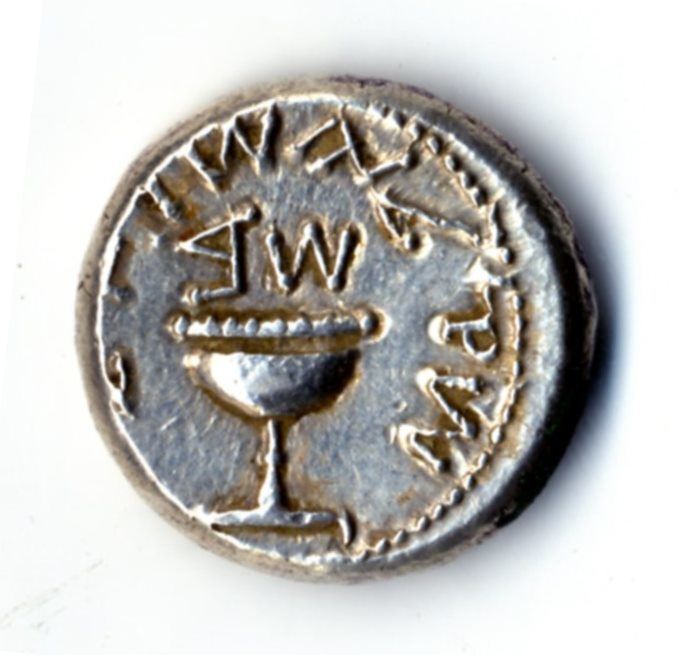
Obv.: Cup with rim of ten pellets, surrounded by Paleo-Hebrew inscription (shekel of Israel). Above the cup, the date (abbreviation of year two). Rev.: Stem with three pomegranates surrounded by an inscription (Jerusalem the Holy). 67/8 C.E. 14.15 grams, 22 mm. Enclosed is a certificate of authenticity.
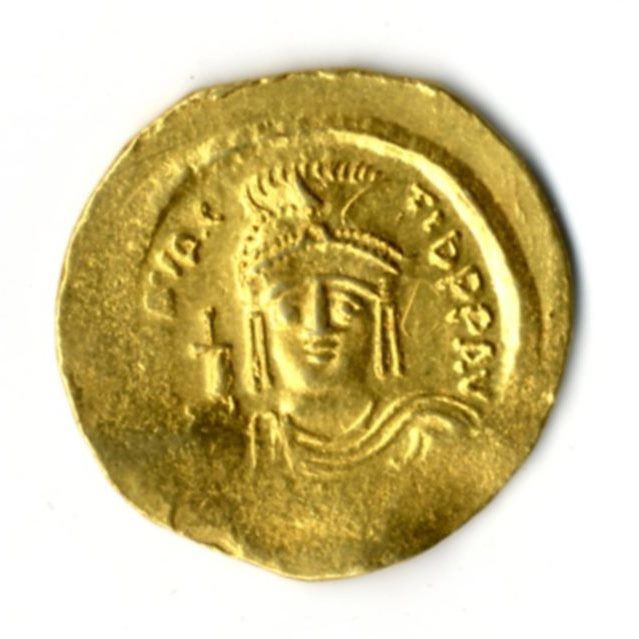
Obv: Portrait of Emperor Maurice Tiberius facing; around inscription, ” ..M AVR TIB PPAUGG”. Rev: Victory facing, holding christogram finialled scepter and christogram finialled orb; inscription around, “VICTORIA AUGG”; in exergue, “CONOB”. Material: 22 kr Gold Denomination: Solidus Date: Ca. 590-602 A.D. 4.35 grams, 20 mm.
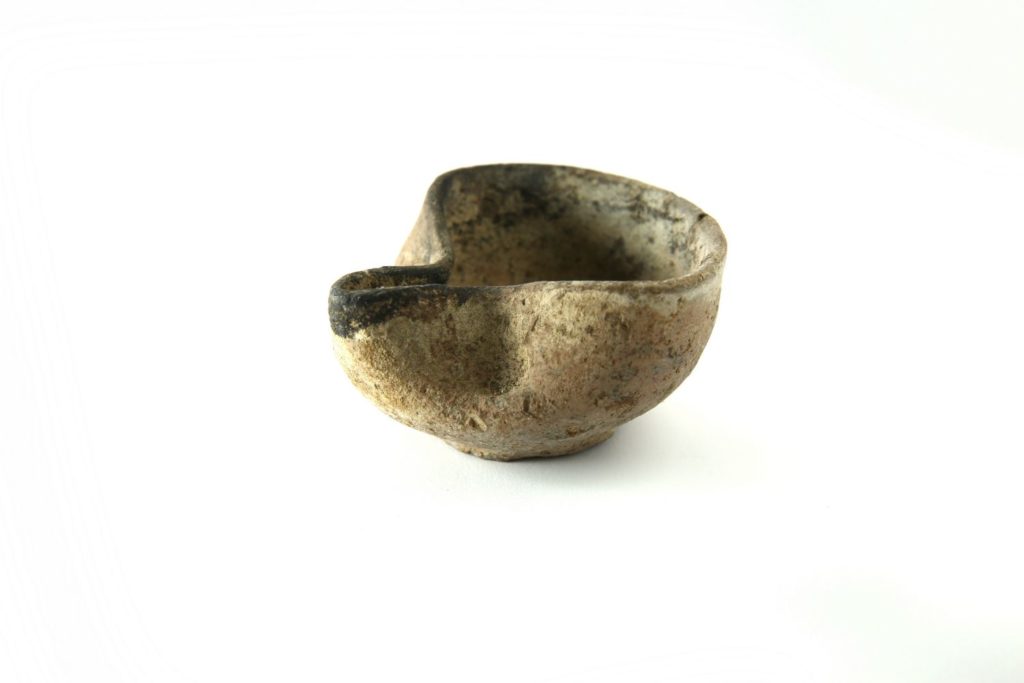
The Islamic period (Islamic rule in the region between the years 638-1917 CE, with a brief interlude of Crusader rule). 6.5×4.6 cm.
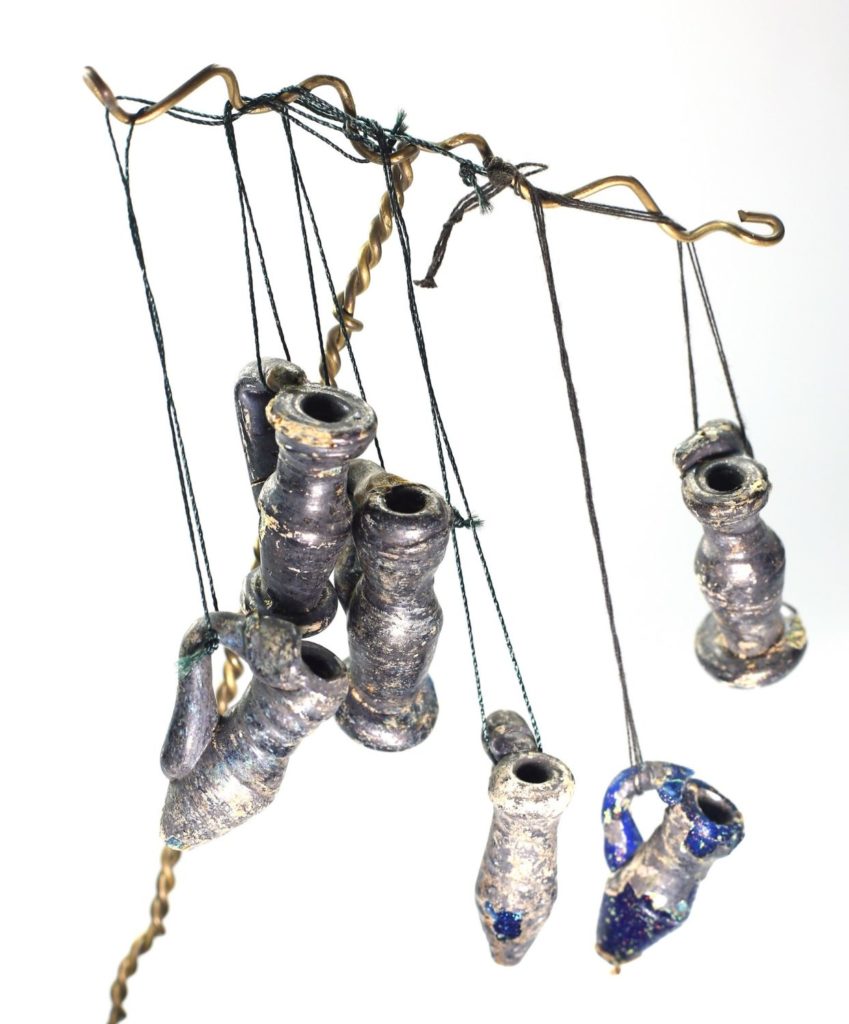
Six complete and one broken (seven in total); fourth and fifth centuries CE; height of each pendant is approximately 3 cm.